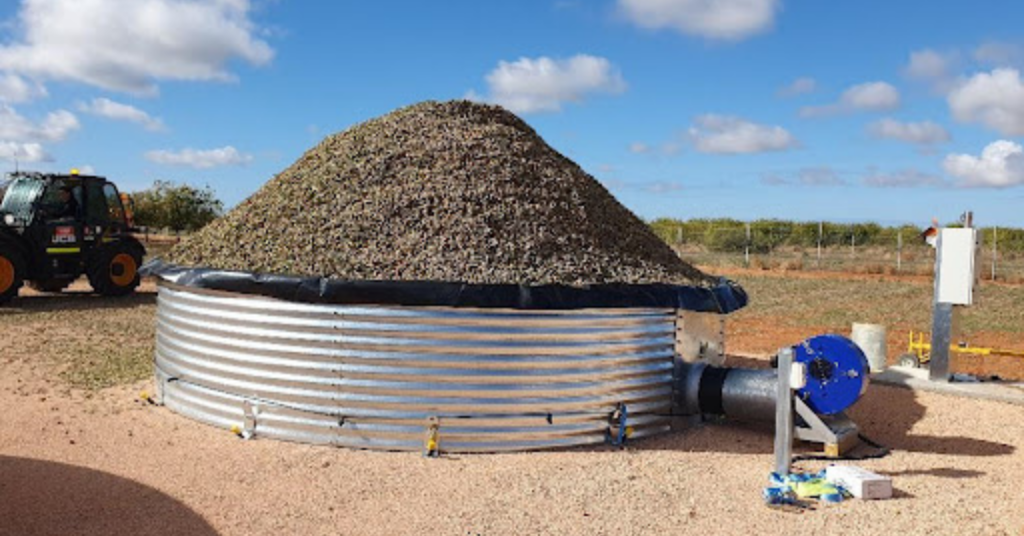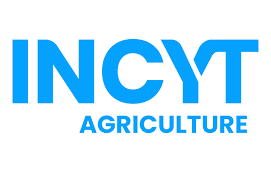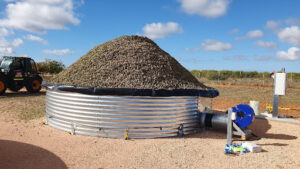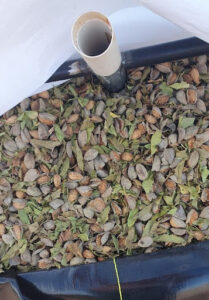
Mildura SmartFarm
The Agriculture Victoria team at the Mildura SmartFarm has successfully demonstrated the drying of wet almonds using ambient aeration. The work is in collaboration with Harveston Aeration Solutions and under the guidance of Dr. Zelmari Coetzee, of the Agriculture Victoria Mildura SmartFarm.
In late 2023, University of South Australia professor John Fielke suggested to Harveston Aeration Solutions that ambient aeration could solve the almond industry’s drying and storage problem. Fielke pointed to previous industry levee sponsored research (AL12003 Advanced processing of almonds) that concluded aeration was a valid method for reducing moisture in harvested almonds.
 The Harveston team devised a solution that combined their product storage and aeration knowledge with this almond-specific research. The completed product is a hybrid solution between a silo and current stockpile bunkers, coupled with an integrated aeration system and a smart controller. The entire solution is dedicated to the on-farm drying, storage and fumigation of almonds until delivery for processing.
The Harveston team devised a solution that combined their product storage and aeration knowledge with this almond-specific research. The completed product is a hybrid solution between a silo and current stockpile bunkers, coupled with an integrated aeration system and a smart controller. The entire solution is dedicated to the on-farm drying, storage and fumigation of almonds until delivery for processing.
 “The system had to be easy to erect and be capable of meeting industry needs for controlling moisture, mold, insects, and vermin. I am very proud of our team’s work and the solution they devised,” said Andrew Fisher, Harveston’s founder.
“The system had to be easy to erect and be capable of meeting industry needs for controlling moisture, mold, insects, and vermin. I am very proud of our team’s work and the solution they devised,” said Andrew Fisher, Harveston’s founder.
 Dr. Coetzee was approached to assist in evaluating the solution. The collaboration with Harveston began with and the project was funded by the AgTech Regional Innovation Network (AgRIN) and Agriculture Victoria Research (AVR). This type of demonstration is part of the SmartFarm’s primary purpose as the Mildura SmartFarm experimental almond orchard is a platform for research and innovation into the management of current and the design of next generation planting systems, and the evaluation of novel AgTech.
Dr. Coetzee was approached to assist in evaluating the solution. The collaboration with Harveston began with and the project was funded by the AgTech Regional Innovation Network (AgRIN) and Agriculture Victoria Research (AVR). This type of demonstration is part of the SmartFarm’s primary purpose as the Mildura SmartFarm experimental almond orchard is a platform for research and innovation into the management of current and the design of next generation planting systems, and the evaluation of novel AgTech.
Three aerated storage rings were constructed at the Mildura SmartFarm. Ring sizes were determined to accommodate for the yield of the farm’s 27 acres (11 hectares) of plantings. After weather conditions significantly delayed the SmartFarm harvest, sourcing suitable harvested fruit for the demonstration proved problematic. Fortunately, a local producer diverted 24 tones (20 tonnes) of wet field weight of shake-and-catch harvested ‘Wood Colony’ almond fruit with a high percentage of leaf trash and the demonstration commenced. The product was at the upper end of moisture expectations and despite being very late in the season, the desired results were achieved.

To ensure rigour in the demonstration, Dr. Coetzee deployed a sensor array from Incyt Agriculture to map the conditions inside the stockpile in detail. Scientific methods for sampling and measuring moisture levels across the fruit, hull, shell and kernel were implemented for the project. The results are shown in Research_Almonds and ambient aeration_1.jpeg.
When analyzing the results, we can see a steady decline in moisture levels within the stack. We can also see where an evaluation of fan run speed was undertaken post day 17 where the drying rate slowed.
“We had the best of the worst conditions for this demonstration,” said Mark White, a Harveston engineer and Ph.D candidate. “We had three rain days, six frost days and many days where the relative humidity fell into the upper levels of the range required. This drastically reduced the number of fan run hours. Yet, we still achieved the desired result.” Research_Almonds and ambient aeration_2.jpeg shows the ambient conditions during the drying phase demonstration.

At the end of the drying phase, the industry standard moisture requirements (AlmondCo 2023 crop delivery information) of 6% kernel, 12% hull and 9% fruit were achieved without loss of quality. The total energy cost for the drying phase was $69 or 1.3 cents per kernel kilograms or 2.2 kernel pounds.
Further evaluations were conducted in the project’s maintenance phase including airflow modification and fumigation effectiveness.

The results of the evaluations will be presented by Australian Almonds in the near future. In all, the team was very happy to demonstrate the effectiveness of ambient aeration and to add to the success of the Mildura SmartFarm.







